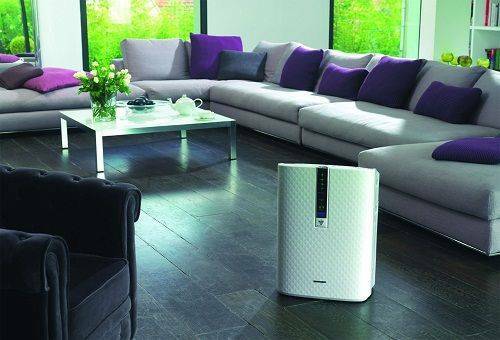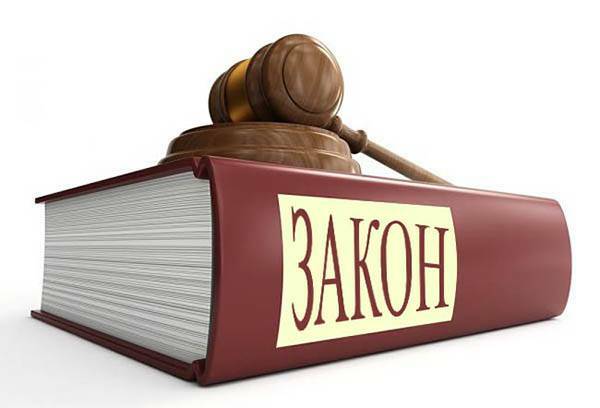Posted on 22.06.
Today, one of the most popular materials for the construction of houses for permanent residence are - gas block and wood (frame houses, from timber, from rounded logs). Let's compare them according to the main criteria that people usually rely on when choosing and buying building materials.
Read in the article
- 1PHOTO: porevit.ru
- 2 The warmth of the walls
- 3 Vapor permeability
- 4 Gas block advantages
- 5 What does the color on the screen of the thermal imager mean?
- 6 How to avoid cold bridges?
The environmental friendliness and safety of the material for the house in which people will live is very important. To build an eco-friendly safe home, you need sustainable building materials.
The environmental friendliness of artificial materials is assessed by such an indicator as the natural radioactivity of a substance. As you know, the lowest activity of radionuclides is observed in sand and lime.
Since aerated concrete consists mainly of sand and lime, it has the lowest radioactivity.
Table 1: Radioactivity of the main building materials
| Construction material | Specific activity Aeff, Bq / kg |
| Granite | 306,8 |
| Granite crushed stone | 243 |
| Clay raw materials | 159 |
| Gravel | 153 |
| Sand | 125 |
| Crushed stone | 140 |
| Blast furnace slag | 116 |
| Expanded clay | 169 |
| Portland cement | 107 |
| Quartz sand | 22 |
| Lime | 18 |
Source: "Environmental safety of building materials and products." E.V. Gulimova, T.A. Mladova, N.V. Muller. Komsomolsk-on-Amur, 2014
On the other hand, environmental friendliness is usually characterized by a certain set of properties, the totality of which was determined by the community of specialists. and is formulated in the form of the requirements of the international standard EcoMaterial 1.0 / 2009 "Certification system for environmentally friendly materials ". If the properties of the building material meet the requirements of the standard, then the material can be called environmentally friendly and can be labeled with the EcoMaterial standard.
Aerated concrete blocks from many manufacturers have this mark, which means that they fully comply with all environmental standards and are safe to use as a building material. In addition, natural natural ingredients are used in their production: lime, gypsum, cement and water.
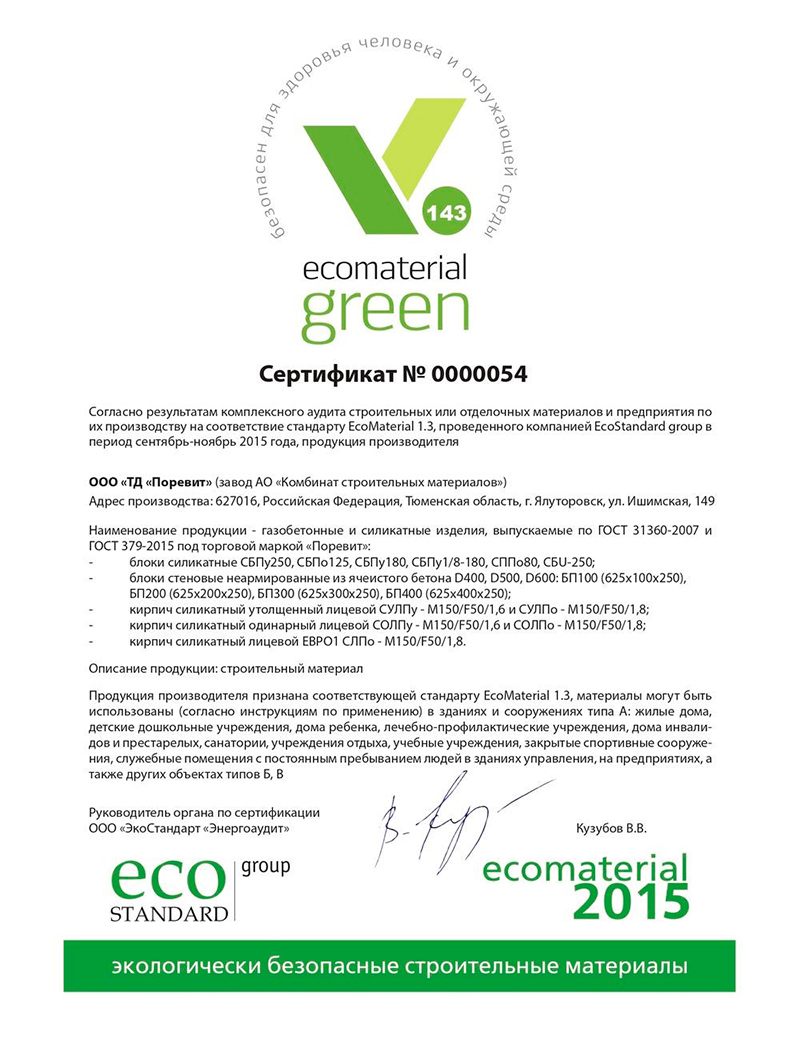
The warmth of the walls
Basically, the warmth of the walls determines whether your home will be warm or cold. Thermal conductivity is the ability of material bodies to conduct energy from a warmer part of the body to a less heated one. The lower this indicator, the less the wall gives off home heat to the street. And the walls of the house are one of the main places where heat loss occurs. Therefore, it is important to take into account the thermal conductivity coefficient when choosing building materials.
The heat indicators of the walls of aerated block and wood are similar, so they are well suited for building a warm house.
| Index | Aerated concrete block | Pine timber (density 540 and below kg / m3) |
| Dry heat conductivity, W / (m ° С) | 0,11 | 0.15 (with a moisture indicator of about 10%) |
| Minimum permissible wall thickness without insulation (for the South of the Tyumen region), Rmin=2,25 | 400 mm. block (R = 3.00) no insulation is needed | 300 mm timber (R = 2.3) no insulation is needed |
Vapor permeability
Vapor permeability is the ability of a material to transmit or retain vapor as a result of the difference partial pressure of water vapor at the same atmospheric pressure and temperature on both sides material.
The fibrous structure of the tree provides it with vapor permeability. That is, the tree "breathes".
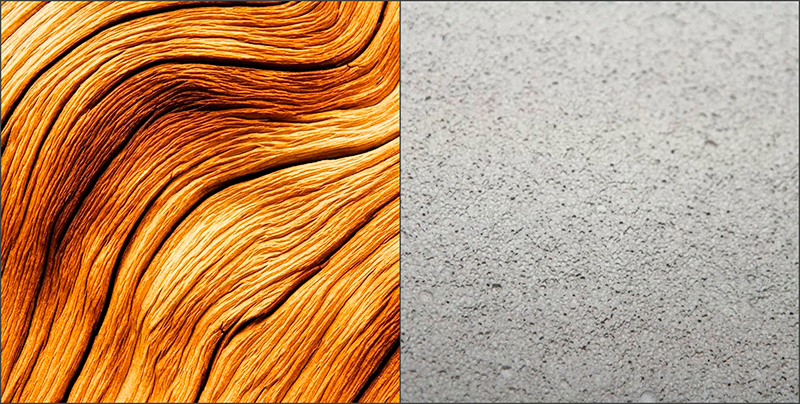
Aerated concrete has a porous structure, which is obtained during its production. In this case, the pores are closed, and air is contained inside them.
At the same time, the gas block, like a tree, has the property of absorbing moisture, with its excess in the room and giving it back when the room is dry. That is, it seems to "breathe". This contributes to the creation of a favorable microclimate in the house.
Gas block advantages
- Does not burn or rot.
Unfortunately, fires are not uncommon. And often the wooden houses that people have been building for a long time, or even have not yet had time to build and live in them, often catch fire.
One of the most important advantages of a gas block over a tree is that it does not burn or rot. For example, tests with a gas burner. After 5 minutes of open fire, the aerated concrete did not change its external data and did not heat up on the back side!
Also, this fact can be confirmed by the fire resistance test report. It can be requested from the factory where you intend to buy the blocks.
- Lack of chemical components for processing.
To extend the service life of some materials, including construction materials, we often have to protect them additionally, processing them with fire retardant, antifungal and other agents containing both safe and harmful substances. Which, of course, somehow affect our health and well-being.
Especially a tree needs this treatment, which is impregnated inside and outside the house, and not by one layer. Indeed, without treatment, a wooden house is much more susceptible to processes such as rotting and mold formation. And it can hardly be said that after this "chemistry" the tree still remains as environmentally friendly and safe. Quite the opposite.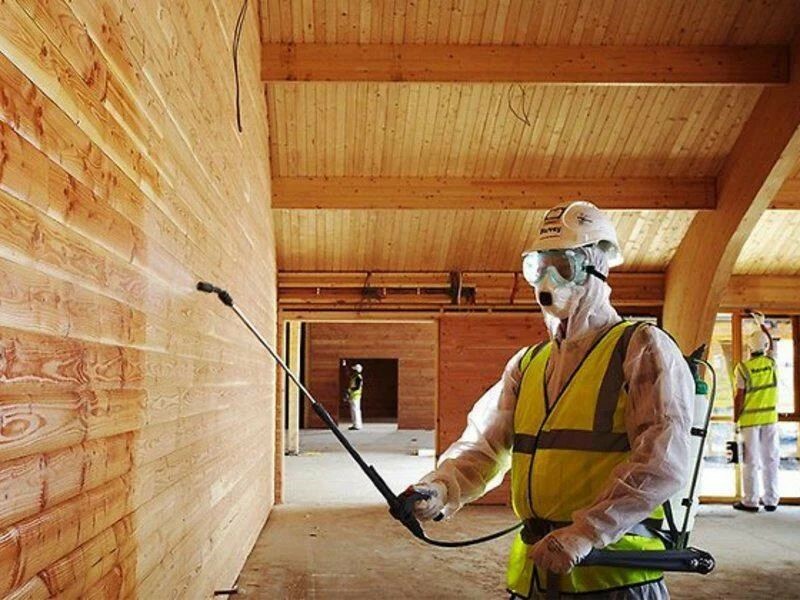
Aerated concrete, unlike wood, does not require mandatory processing with different chemical compositions. Houses made of aerated concrete can stand for a long time without exterior decoration. For the wintering period, it is also not necessary to treat it with water repellents, etc., it is enough to protect the block from the constant influence of snow and water.
Thus, aerated concrete is a more environmentally friendly material, from which houses are safe and comfortable to live in.
- Lack of cold bridges.
Cold bridges are areas in the structure of a house through which heat leaks. The greatest heat loss most often occurs through walls that are built either from cold materials or from violation of technology (for example, the thickness of the material was incorrectly selected for the region in which the object is located construction).
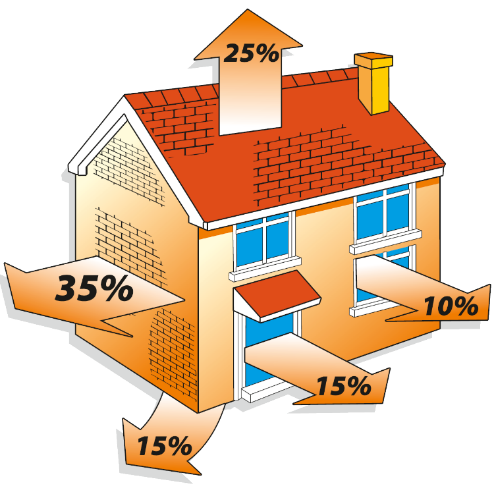
Therefore, it is important to minimize cold bridges and think over these methods even at the design and construction stage of the "box" at home.
What does the color on the screen of the thermal imager mean?
Consider photographs from thermal imaging of a house made of wood and an aerated block.
If shooting from the street:
- Red - the hottest places, i.e. through which the greatest heat loss occurs (for example, windows).
- Green - the average temperature between the coldest and the hottest spot on the thermal imager screen.
- Blue - the coldest places, i.e. there is minimal heat loss.
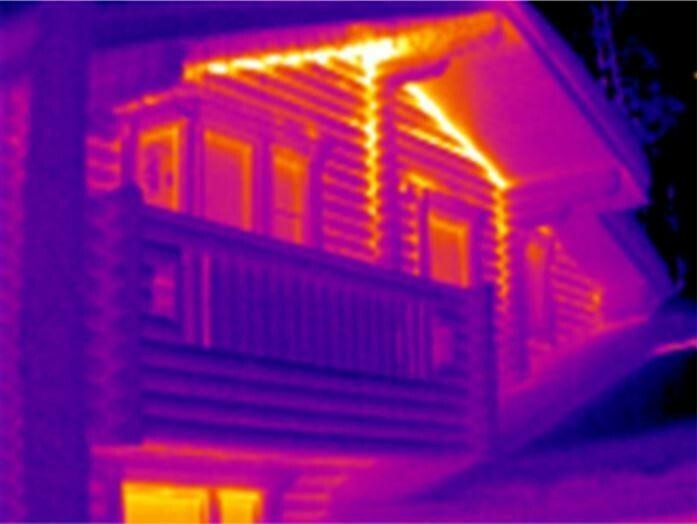
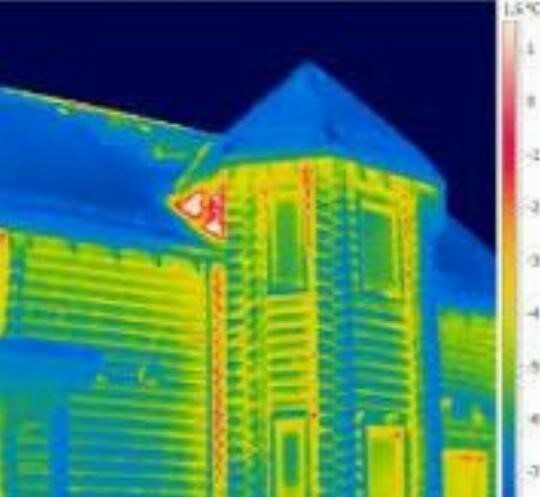
Timber houses do not retain heat very well due to leakage through cracks in walls and corners). It is possible and necessary to caulk them, but to do it tightly is almost impossible: the tree breathes, changes size and volume under the influence of temperature.
A house for summer residence with a sauna made of aerated concrete blocks:
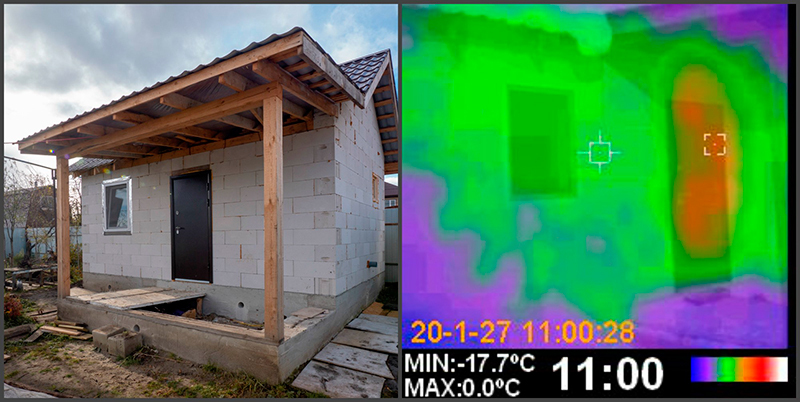
And another house made of aerated concrete without exterior decoration:
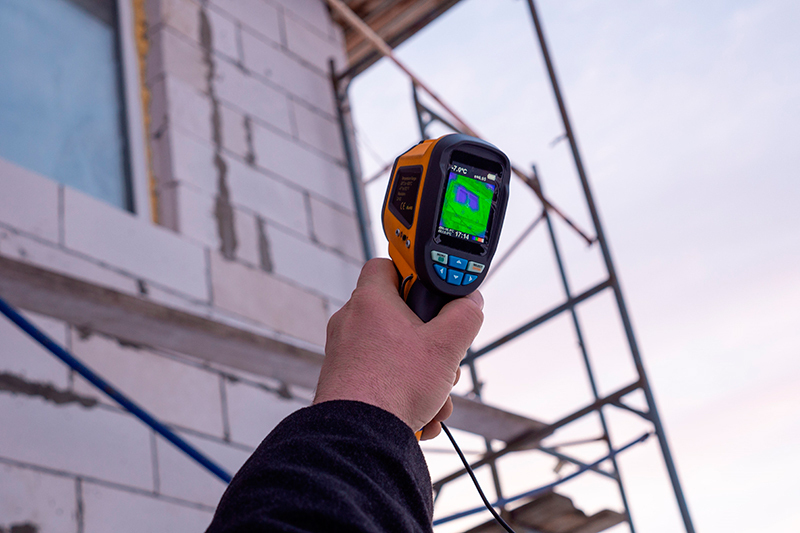
We see on the screen of the thermal imager a uniform green color of the walls, which indicates that the masonry is made of high quality, the thickness of the walls is chosen correctly, and therefore there is no heat leakage through the walls.
How to avoid cold bridges?
In wooden houses, the number of cold bridges can be minimized by laying tow in horizontal seams. At the same time, too tight joints of the timber with each other are not allowed, since the wood swells from moisture, which can lead to ruptures in the absence of the necessary compensation gap.
When building a house from an aerated block, you can masonry in two layers, for example, a block 300 mm wide and 100. With this method, the vertical seam is displaced, let's call it checkerboard masonry.
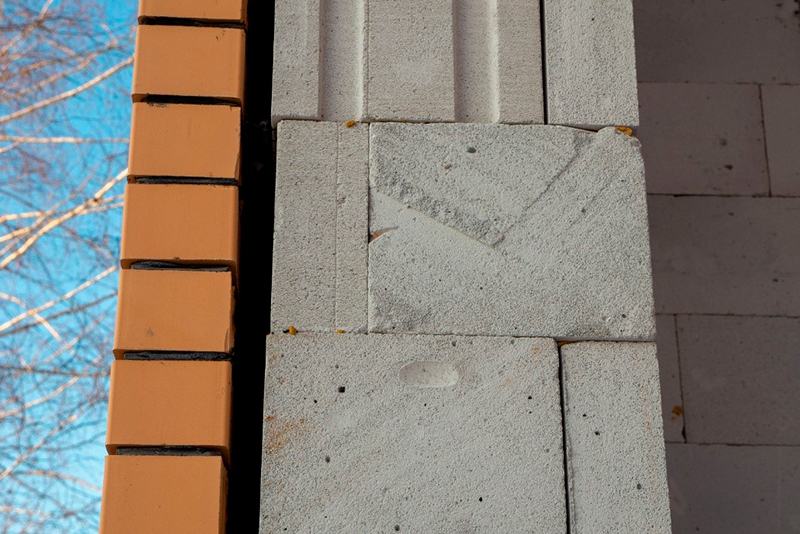
Also, laying blocks on foam glue, less than 1 mm thick, which allows you to make the wall almost monolithic, that is, homogeneous.

| Property | Gas block | Wood |
| Environmental friendliness | ✔ | ✔ |
| Vapor permeability | ✔ | ✔ |
| Not susceptible to burning | ✔ | ✖ |
| The warmth of the walls, the absence of cold bridges | ✔ | ✖ |
| Lack of chemicals for surface treatment and protection | ✔ | ✖ |
We compared with you two popular materials for building a house: aerated concrete block and wood. They also talked in detail about the properties in which they are similar, for example, both are equally environmentally friendly and safe, have good vapor permeability. The essential difference between these materials is that the wood burns, and is also subject to decay and additional protection in the form of impregnations and compounds, while aerated concrete does not. Also, from aerated concrete, subject to building standards for wall thickness and correct masonry, you can build a really warm house, without cold bridges.
So, we saw the undeniable advantages of aerated concrete over wood, which make it an excellent material for building a house.

